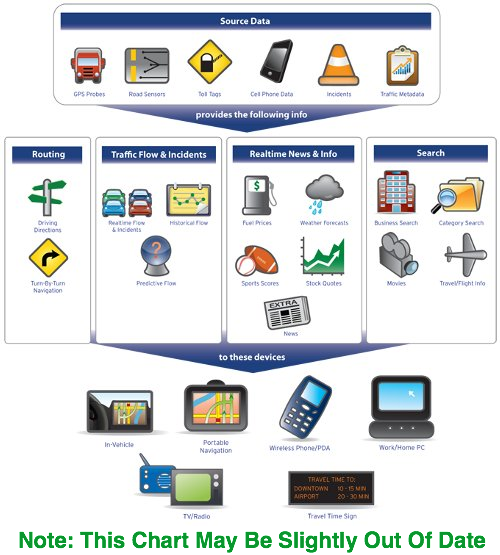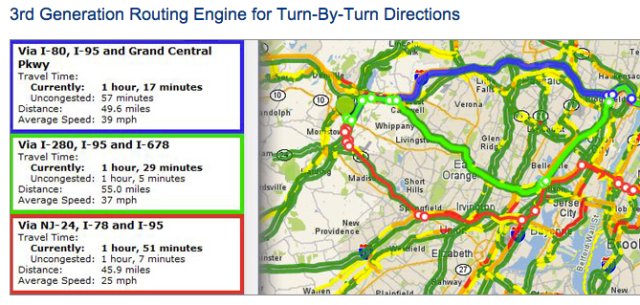Black Friday online shopping sales were up 26% this year, the number of people driving to brick and mortar stores increased even faster says Inrix. Congestion was up 32.5% this year according to the traffic data Inrix now pulls from over 100 million drivers. This and another report about Thanksgiving traffic show the quiet giant is intent on raising its profile before its planned 2013 IPO.
You might not even realize that you’re already an Inrix user. Sure, in the wake of Apple’s #MapsFail, traffic app Waze got a big boost up to reach 30 million registered users. But Inrix already has 100 million users every day, and powers maps for Garmin, MapQuest, Ford, and BMW.
Where’s all this data coming from? Actually, where did Inrix come from? The startup spun out of Microsoft’s automotive research lab in 2004. Since then it’s signed deal after deal to sell traffic data to practically anyone…so long as they collect that same data and send it back to Inrix.
This crowdsourced model keeps on snowballing. Now Inrix has data on 1.8 million miles of road in 35 countries. Six of the top eight automakers with built-in navigation systems and eight of the top twelve iOS map apps rely on Inrix. Beyond developers and car manufacturers, it sells data to governments, TV and radio stations for on-air traffic reports, commercial fleets like UPS, and traffic websites. It has its own navigation app, plus a clever partnership with mobile carriers that lets it use data about when phones switch from tower to tower to calculate traffic.

All these sources helped it determine which cities would have the worst Thanksgiving delays on the road. Sure, everyone loves to laugh at the terrible traffic in Los Angeles, but Silicon Valley better hold its tongue. Inrix’s data predicted that after LA, San Francisco would have the second longest delays, followed by New York, Chicago, and DC. On Black Friday, traffic at all 10 of the top US malls was up from last year. #1 Mall Of America in Minnesota saw congestion up 29.6% while traffic increased a staggering 57.1% at #7 shopping center The Woodfield Mall in Illinois.
Since Inrix’s data gets white-labeled so often, it has to start getting its name out there of it wants to make a splash on the public market. In April CEO Bryan Mistle told Bloomberg that Inrix was planning an IPO where it would seek to raise $75 million to $100 million by selling 10% to 15% of its shares. That could value the company at $1 billion. Then last month the Wall Street Journal reported that Inrix had hired Goldman Sachs and JP Morgan as underwriters for the IPO.

I spoke with Mistle and he refused to comment on the IPO, but my sources say it’s still on track for 2013. He’s the right guy to lead the company. Mistle grew up in Detroit and previously worked at Ford and General Motors. He’s passionate about solving traffic which wastes 2 billion gallons of gas a year in America alone as is a serious a serious environmental issue. “There’s few companies in the world having as big an impact on one of the world’s biggest problems as we are.”
That’s because even if just a small number of vehicles learn about and avoid a traffic jam, it can alleviate the clog. Mistle tells me”It’s a geometric graph [similar to an exponential graph], not a linear graph. If you have a 5% impact on traffic congestion you could almost solve traffic problems [altogether].”
Providing accurate traffic data is a huge challenge, though. Mistle explains:
“Apple found out that it’s a lot harder than you think. Just because you have GPS data doesn’t mean you understand traffic. It’s not just enough to get speed data. There are vehicles on the side of the road and you don’t want to show that traffic has stopped. In a snow storm you don’t want to say traffic is free-flowing [just because there are no cars on the road]. Someone could be riding a bike rather than in a car. There’s a lot of analytics and algorithms that go into creating high-quality maps and traffic data. That’s why Inrix has over 100 patents.”
If Inrix can make the world realize just how critical its data is, it could raise plenty of money to augment its $68.1 million in venture funding and fend off competitors TomTom and Nokia’s NavTeq. A full war chest would allow it to accelerate its pursuit of what Mistle tells me are Inrix’ three big goals: getting onto as many devices as possible, geographic expansion from 35 to a total of 50 new countries in 2013, and investment beyond data in analytics and applications. Then maybe people will realize it’s Inrix that got them home safe.
[Image Credit: NaviGadget]